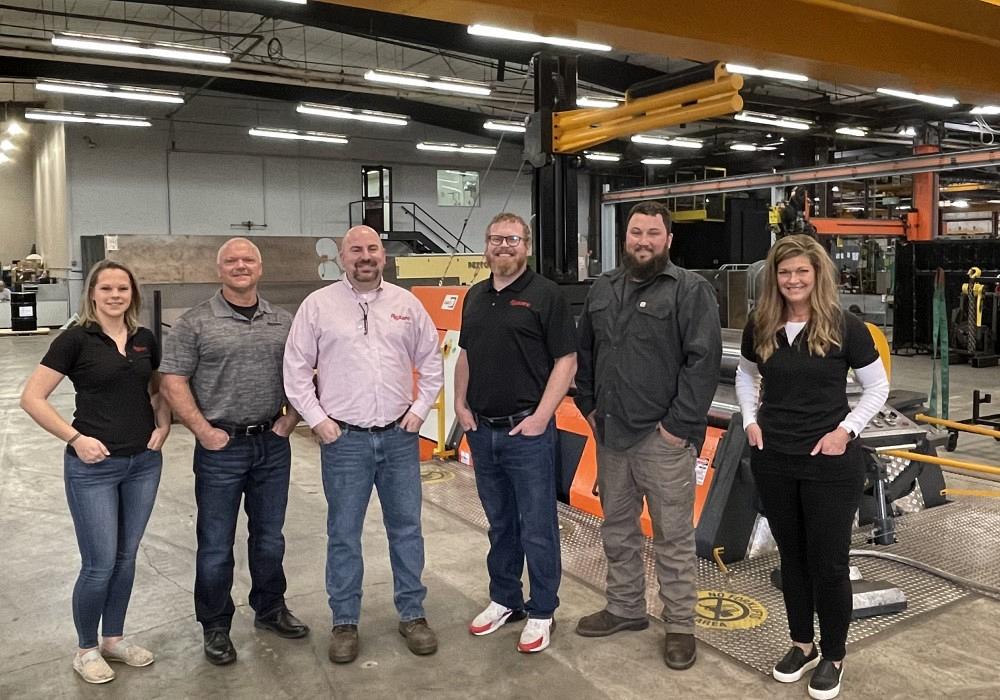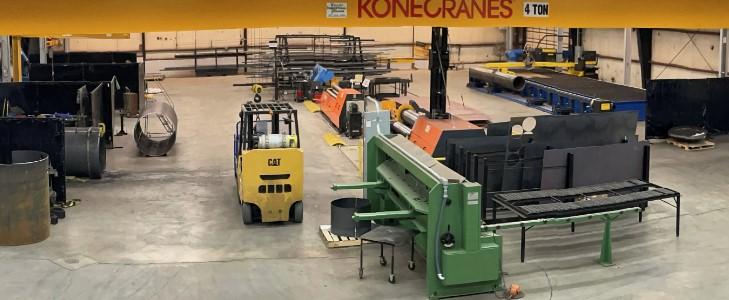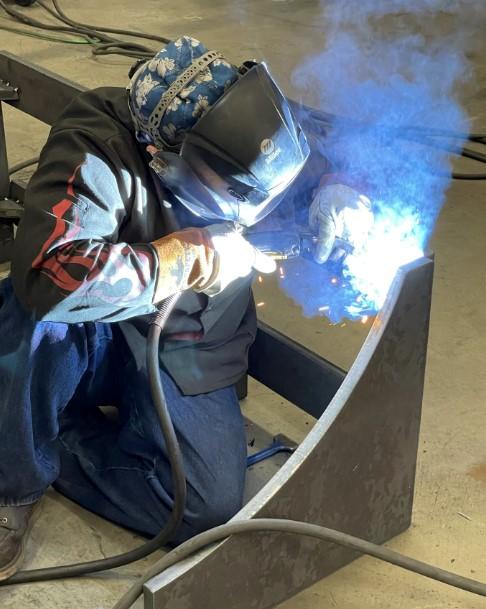Senior Editor
- FMA
- The Fabricator
- FABTECH
- Canadian Metalworking
Categories
- Additive Manufacturing
- Aluminum Welding
- Arc Welding
- Assembly and Joining
- Automation and Robotics
- Bending and Forming
- Consumables
- Cutting and Weld Prep
- Electric Vehicles
- En Español
- Finishing
- Hydroforming
- Laser Cutting
- Laser Welding
- Machining
- Manufacturing Software
- Materials Handling
- Metals/Materials
- Oxyfuel Cutting
- Plasma Cutting
- Power Tools
- Punching and Other Holemaking
- Roll Forming
- Safety
- Sawing
- Shearing
- Shop Management
- Testing and Measuring
- Tube and Pipe Fabrication
- Tube and Pipe Production
- Waterjet Cutting
Industry Directory
Webcasts
Podcasts
FAB 40
Advertise
Subscribe
Account Login
Search
A metal fabricator focused on professional (and personal) growth
Rexarc’s quest for revenue diversification and a happy manufacturing workforce
- By Tim Heston
- July 12, 2021
- Article
- Shop Management

Part of the Rexarc team poses in front of the company’s new plate roll. From left, Marci Nagel, accounting/HR; Greg Rush, business development manager; Mark Elliott, operations manager; Rob Moyer, CEO; Travis Strebig, lead design engineer; and Gretchen Jones, COO. Images: Rexarc
In the early 2000s, as president of Rexarc International Inc., a fabricator in southwest Ohio, Joe Smith never left home without his business card. Sure, Rexarc served a very business-to-business niche, fabricating acetylene cylinder charging plants and gas distribution systems for the fuel gas industry, but what if he were to meet a prospective customer by chance? Without a business card, a serendipitous meeting could turn into a lost opportunity.
So in 2005, when Smith asked his stepgrandson Rob Moyer if he had a business card, Moyer knew the drill. “I thought he was testing me,” said Moyer, who was executive vice president at the time. “So I pulled my business cards out of my wallet and presented them to him.”
Smith glanced at the cards, said he thought he needed some new ones, then put a set of newly purchased cards on his desk. They said, “Rob Moyer, President.”
Moyer stared at the freshly printed cards. “He told me, ‘I’ll help you however you need. But I’ve seen too many companies not achieve their potential because the old man wouldn’t get out of the way. And I’m here for you. But me being here is not going to get you to where you want to go.’” Moyer had joined the company just three years before, and now, at 22 years old, he was leading it.
In 2021 Moyer remains at the helm, and he’s now pushing West Alexandria, Ohio-based Rexarc in a new direction. For most of its history the organization had relied on outside companies to roll and fabricate the tanks and vessels that went into its acetylene plant products. Over the past few years, though, the company delved into ASME code-level fabrication of pressure vessels. Today the company not only fabricates its own vessels and tanks for its fuel-gas system product lines, but it also sells its custom vessel, tank, and pipe fabrication services.
Moyer pushed for the expansion for two reasons. One, the contract work should help counteract the cyclical nature of the acetylene business. Two, the strategy has buttressed a shop floor culture that encourages professional growth. For most at Rexarc, a career isn’t a static thing.
“Manufacturing is our mechanism,” Moyer said, “but we’re all about allowing people to grow.”
He added that this doesn’t trivialize manufacturing but instead does the exact opposite. The act of metal fabrication has become a meaningful part of people’s lives, which drives innovation and attracts talent, all of which builds the foundation for future growth.
Emerging From Tragedy
Even at 22, Moyer was no stranger to personal growth. His stepfather Fred Smith had led Rexarc until tragedy struck in 2001. Smith was murdered during a weekend trap-shooting event, where he was kidnapped by a woman and her boyfriend and killed with a shovel.
“I think when you’re faced with adversity, you have two choices,” Moyer told the Dayton Business Journal in 2005. “You can crawl up in a hole and never recover, or you excel.”

In 2020 Rexarc’s shop floor teams reorganized the facility for optimal flow with the company’s new bending rolls and burn table.
Moyer chose the latter. In 2002 he left the University of Cincinnati, where he was studying education, to join the family business, where his stepgrandfather Joe Smith had again taken the reins (though he’d return to college and get a degree in education and corporate training and development in 2011 from Ohio State).
In 2005 Smith gave Moyer his new set of business cards. Rexarc had entered its fourth generation of leadership.
A Century of Fabrication
A typical gas welding setup in the early 20th century didn’t entail oxygen and acetylene cylinders shipped from a distribution plant. Instead, welding operations drew acetylene directly from portable acetylene generators.
Acetylene is produced from a reaction between calcium carbide and a source of moisture, usually water. Acetylene gas starts life as a bubble (think of the plop-plop fizz-fizz of Alka-Seltzer) that rises to the water’s surface and is captured for use. Such generators needed a steady supply of calcium carbide, yet in the 1920s welders had no quick way of knowing how much calcium carbide their generator had in its hopper. If they ran out in the middle of welding, they’d scrap what they were working on and start over.
“So back in the 1920s,” Moyer said, “a local inventor and entrepreneur [Joe Smith’s father, Carl Smith] had the idea of putting a Pyrex viewport into the calcium carbide hopper for these portable acetylene generators. This enabled operators to decide whether they had enough fuel before starting a job. It enabled so much more productivity. And that was the spark that started our business.”
The company’s first product, the Sight Feed acetylene generator, soon found use in a variety of applications. Some of the firm’s products even generated fuel for the acetylene lamps used during the U.S.’s island-hopping campaign in World War II. The lamps required no electricity, and they could quickly flare up as needed—for war planes taxiing, taking off, and landing—before diminishing rapidly into darkness. (Similar generators, using calcium carbide made from lime and coke, fueled acetylene lamps that lit theaters before electrification. It’s where the phrase “in the limelight” comes from.)
Over the ensuing decades, the acetylene business evolved from portable generation to one where one acetylene generator could fuel an entire factory. To meet this changing demand, Rexarc began fabricating larger, stationary acetylene generation plants and piping systems.
Then came the beginnings of today’s regional gas distribution system, where large distributors generated and stored the gas on a large scale and delivered cylinders to customers. The generation method occurred at relatively low pressure and high volume, which presented several challenges.
“Due to the nature of acetylene, this was inherently inefficient,” Moyer explained, “and it created a large storage area for acetylene, which could cause a safety challenge. We thought there had to be a better way.”
During the postwar years, the company developed a system that uses 7 to 8 PSI, a medium level of pressure that makes the gas generation efficient, safe, and easy to start up and shut down. “This really was a revolution in the acetylene business,” Moyer said, “because now it allowed [acetylene generation] to occur regionally, instead of at extremely large facilities. And it made efficient acetylene generation accessible to independent business owners.”
About Leadership
Greg Rush’s metal fabrication career began in the late 1980s, a time when he learned how a poor company culture is created. “I remember some bosses thought that the madder they made me, the harder I would work. I knew that wasn’t right, and I knew that if I ever got the opportunity to lead people, I at least knew what not to do.
“I learned early on that you need to empower people. You look for patterns, of course, so you know the right person is in the right seat. But you need to give them the tools so they can make the decisions, and you support those decisions.”
Rush joined Rexarc in 2011 as director of operations, and a few years later he approached Moyer with a proposal: He wanted to pursue training as a coach. “At the time I was managing people, and as I told Rob, we’re really coaching. We’re not making people do something. We’re wanting people to choose to do something. That’s how you get engagement beyond the ‘clock in, go make the doughnuts, and clock out.’ When you get people motivated and they choose to do something, the end result is phenomenal.”
When Rush first made his proposal about coaching, Moyer hesitated slightly. After all, Rexarc was still a small company, with fewer than 15 people. Did the company really need someone with coach training? “I felt we didn’t have an immediate need,” Moyer said. “We’re a small organization. But Greg was passionate about it, and I thought he could pass on his knowledge and help other people. So we put him through a Dale Carnegie course, and he received the highest award for achievement among his group.
“Greg has always been very personable,” Moyer continued, “but before this training, he was unable to stand in front of a group of people. Now, through his development, he’s engaging with people in such a different way. He’s now sales manager in charge of our new [ASME contract fab] business, and he’s been building relationships over the past seven months. Without that training, I really don’t believe we would be quite where we are today. We’ve definitely seen some very tangible results.”
Those results came at an opportune time. By the 2010s Rexarc was a well-established player in the acetylene-generator-plant market. Over decades it had built a business using a network of outside fabricators, a strategy that made perfect sense considering the cyclical nature of Rexarc’s business. Its core competencies were in system design, assembly (including manual plasma cutting and arc welding), and supporting those systems after they were delivered to customers.
Unfortunately, the acetylene generation market remains stubbornly variable, with boom-bust cycles occurring every decade or so. This forced Rexarc to hire during the boom times and then downsize when demand levels slumped.
“We always managed through the cycles, but I knew this wasn’t something I wanted to do in my entrepreneurial venture,” Moyer said. “So I looked at the business and asked, ‘What’s the through line?’” The connecting theme was tank, vessel, and pipe fabrication, much of which was sourced to local suppliers. “What would the business case look like to in-source this work?”
The company had some cutting and rolling capability, including an old plate roll, a shear, and a band saw. And it had a mechanized subarc welding system. But beyond that, most welding and cutting was done manually, and the vast majority of material was purchased prefabricated.
Several years ago Rexarc began dipping its toe into contract work. After all, many of its existing customers who purchased acetylene plants also needed other industrial fabrications. But Rexarc’s limited in-house capabilities meant that its wins were also limited. So company leaders began developing the business case for bringing in a plasma and oxyfuel cutting table as well as two sets of plate rolls. Analyzing the market, they found a harsh reality that anyone in custom and contract fabrication knows all too well: It’s a capital-intensive and incredibly competitive market.
“Still, knowing that we didn’t have the exact business case, about 18 months ago I took a leap of faith and said we were going to go for it,” Moyer said. “We knew there had to be a market out there, and that we just weren’t getting the wins we believed we could. So, we spent all of 2020 bringing in equipment and completely re-laying out our facility.”
Rexarc used the slow times during the pandemic to its advantage. It’s actually difficult for workers to be physically close to each other when assembling large industrial equipment, so Rexarc already had a kind of natural social distancing built into its processes. Shop floor teams reorganized certain value streams, including one it had for compressors (a critical acetylene plant component) for better work flow. Whereas before components came from all areas, in spaghetti-diagram fashion, compressor components now flow in one direction and in one area of the plant.
Rexarc had practiced some basics of lean manufacturing for years, including 5S, which freed floor space for additional equipment. The company invested in a Kaast 20- by 40-ft. plasma and oxyfuel table, with 5-axis cutting capability and an attachment for cutting (including bevel-cutting) pipe up to 24 in. in diameter. It also purchased two Kaast 8-ft. plate rolls, with the heavy-duty roll able to form plate up to about 1.75 in. thick, depending on the length of bend, material strength, and desired diameter. The rolls also have overhead arms to support thin tank and vessel shells during the rolling process, without tying up a crane or other support device. (A rolled round form of thin-gauge material can turn slightly oval under its own weight if left unsupported.)
Such improvements don’t just happen, and neither do new opportunities in contract vessel and pipe fabrication and ASME code-level work. Here, Moyer said, is where the people-development side of management plays a critical role.
Moyer used plate rolling as a prime example. The company hired a talented plate rolling lead, but if the shop wants to expand its plate rolling capacity, simply buying more equipment isn’t enough. Plate rolling is an art, and it hinges largely on the rolling talent a fabricator can hire or train over time. If a shop supports such talent development over the long term, it has a better chance of success.
The same holds true with company culture overall. If Rexarc simply hired to fill positions and abided by a top-down, don’t-ask-questions culture, the company wouldn’t have been able to transform its operations to support both its acetylene and contract businesses.
Its culture of personal and professional growth attracted talent, including a welder and certified welding inspector (CWI) who previously taught at the nearby Hobart Institute of Welding Technology. It also helped a one-time paint operator (the company has an electrostatic paint booth) advance into welding and, eventually—after a stint at a Dale Carnegie course—into operations management. And everyone at the company enters their job knowing to expect a healthy dose of cross-training, so that, as Moyer put it, people can “move where the bubble is” to get products out the door.
“Our training philosophy is holistic in nature,” Moyer said. “It’s not just skills-focused. We look at communication skills and consider the entire individual. We ask, ‘You’re here today, but where do you want to be in the future, and how can we help get you there?’ Even being the small organization that we are [with 16 employees], we have come a long way through this kind of development and personal growth.”
Such development helped Rush become a better salesperson at the right time to build Rexarc’s contract fabrication business, which in 2021 is gaining some real traction in aerospace and other sectors outside the company’s core industrial customer base.
“I think continuous improvement is a bit of a cliché,” Rush said. “It’s really about continuous growth, and from that personal growth, improvement comes.”
About the Author

Tim Heston
2135 Point Blvd
Elgin, IL 60123
815-381-1314
Tim Heston, The Fabricator's senior editor, has covered the metal fabrication industry since 1998, starting his career at the American Welding Society's Welding Journal. Since then he has covered the full range of metal fabrication processes, from stamping, bending, and cutting to grinding and polishing. He joined The Fabricator's staff in October 2007.
Related Companies
subscribe now

The Fabricator is North America's leading magazine for the metal forming and fabricating industry. The magazine delivers the news, technical articles, and case histories that enable fabricators to do their jobs more efficiently. The Fabricator has served the industry since 1970.
start your free subscription- Stay connected from anywhere

Easily access valuable industry resources now with full access to the digital edition of The Fabricator.

Easily access valuable industry resources now with full access to the digital edition of The Welder.

Easily access valuable industry resources now with full access to the digital edition of The Tube and Pipe Journal.
- Podcasting
- Podcast:
- The Fabricator Podcast
- Published:
- 04/16/2024
- Running Time:
- 63:29
In this episode of The Fabricator Podcast, Caleb Chamberlain, co-founder and CEO of OSH Cut, discusses his company’s...
- Trending Articles
AI, machine learning, and the future of metal fabrication

Employee ownership: The best way to ensure engagement

Steel industry reacts to Nucor’s new weekly published HRC price

Dynamic Metal blossoms with each passing year

Metal fabrication management: A guide for new supervisors

- Industry Events
16th Annual Safety Conference
- April 30 - May 1, 2024
- Elgin,
Pipe and Tube Conference
- May 21 - 22, 2024
- Omaha, NE
World-Class Roll Forming Workshop
- June 5 - 6, 2024
- Louisville, KY
Advanced Laser Application Workshop
- June 25 - 27, 2024
- Novi, MI




























